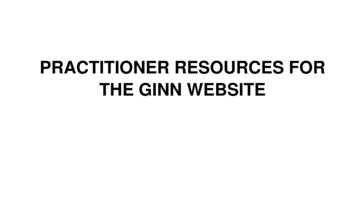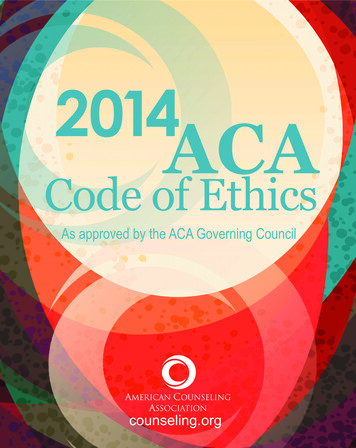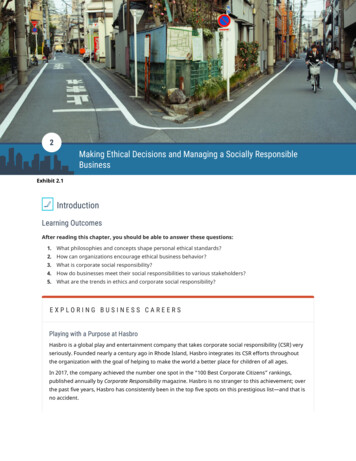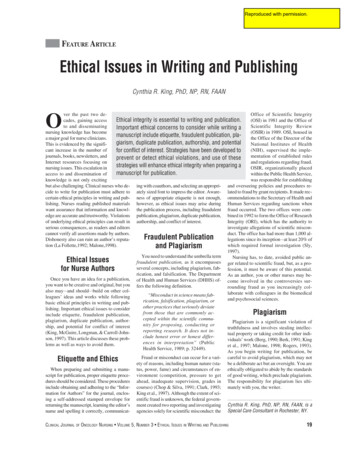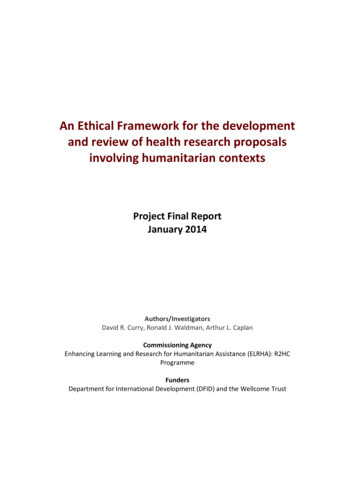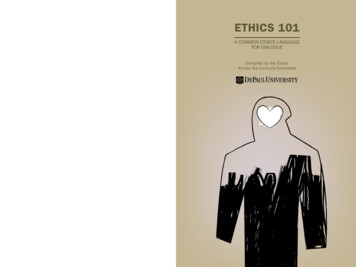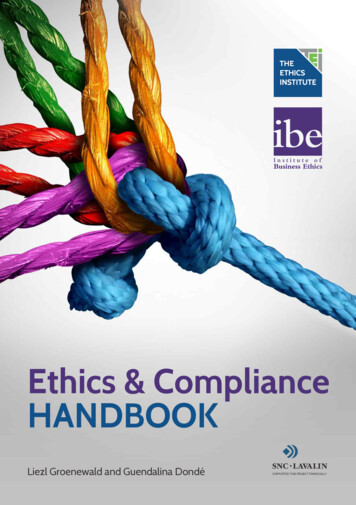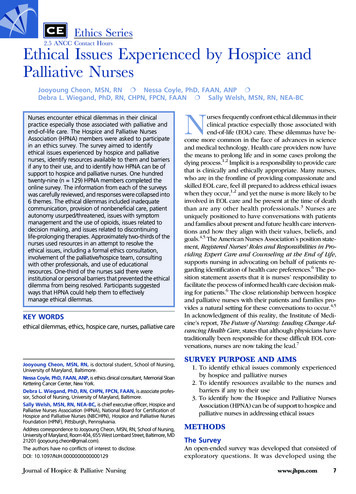
Transcription
Ethics Series2.5 ANCC Contact HoursEthical Issues Experienced by Hospice andPalliative NursesJooyoung Cheon, MSN, RN ƒ Nessa Coyle, PhD, FAAN, ANP ƒDebra L. Wiegand, PhD, RN, CHPN, FPCN, FAAN ƒ Sally Welsh, MSN, RN, NEA-BCNurses encounter ethical dilemmas in their clinicalpractice especially those associated with palliative andend-of-life care. The Hospice and Palliative NursesAssociation (HPNA) members were asked to participatein an ethics survey. The survey aimed to identifyethical issues experienced by hospice and palliativenurses, identify resources available to them and barriersif any to their use, and to identify how HPNA can be ofsupport to hospice and palliative nurses. One hundredtwenty-nine (n 129) HPNA members completed theonline survey. The information from each of the surveyswas carefully reviewed, and responses were collapsed into6 themes. The ethical dilemmas included inadequatecommunication, provision of nonbeneficial care, patientautonomy usurped/threatened, issues with symptommanagement and the use of opioids, issues related todecision making, and issues related to discontinuinglife-prolonging therapies. Approximately two-thirds of thenurses used resources in an attempt to resolve theethical issues, including a formal ethics consultation,involvement of the palliative/hospice team, consultingwith other professionals, and use of educationalresources. One-third of the nurses said there wereinstitutional or personal barriers that prevented the ethicaldilemma from being resolved. Participants suggestedways that HPNA could help them to effectivelymanage ethical dilemmas.KEY WORDSethical dilemmas, ethics, hospice care, nurses, palliative careJooyoung Cheon, MSN, RN, is doctoral student, School of Nursing,University of Maryland, Baltimore.Nessa Coyle, PhD, FAAN, ANP, is ethics clinical consultant, Memorial SloanKettering Cancer Center, New York.Debra L. Wiegand, PhD, RN, CHPN, FPCN, FAAN, is associate professor, School of Nursing, University of Maryland, Baltimore.Sally Welsh, MSN, RN, NEA-BC, is chief executive officer, Hospice andPalliative Nurses Association (HPNA), National Board for Certification ofHospice and Palliative Nurses (NBCHPN), Hospice and Palliative NursesFoundation (HPNF), Pittsburgh, Pennsylvania.Address correspondence to Jooyoung Cheon, MSN, RN, School of Nursing,University of Maryland, Room 404, 655 West Lombard Street, Baltimore, MD21201 (jooyoung.cheon@gmail.com).The authors have no conflicts of interest to disclose.DOI: 10.1097/NJH.0000000000000129Journal of Hospice & Palliative Nursingurses frequently confront ethical dilemmas in theirclinical practice especially those associated withend-of-life (EOL) care. These dilemmas have become more common in the face of advances in scienceand medical technology. Health care providers now havethe means to prolong life and in some cases prolong thedying process.1,2 Implicit is a responsibility to provide carethat is clinically and ethically appropriate. Many nurses,who are in the frontline of providing compassionate andskilled EOL care, feel ill prepared to address ethical issueswhen they occur,1,2 and yet the nurse is more likely to beinvolved in EOL care and be present at the time of deaththan are any other health professionals. 3 Nurses areuniquely positioned to have conversations with patientsand families about present and future health care interventions and how they align with their values, beliefs, andgoals.4,5 The American Nurses Association’s position statement, Registered Nurses’ Roles and Responsibilities in Providing Expert Care and Counseling at the End of Life,supports nursing in advocating on behalf of patients regarding identification of health care preferences.6 The position statement asserts that it is nurses’ responsibility tofacilitate the process of informed health care decision making for patients.6 The close relationship between hospiceand palliative nurses with their patients and families provides a natural setting for these conversations to occur.4,5In acknowledgment of this reality, the Institute of Medicine’s report, The Future of Nursing: Leading Change Advancing Health Care, states that although physicians havetraditionally been responsible for these difficult EOL conversations, nurses are now taking the lead.7NSURVEY PURPOSE AND AIMS1. To identify ethical issues commonly experiencedby hospice and palliative nurses2. To identify resources available to the nurses andbarriers if any to their use3. To identify how the Hospice and Palliative NursesAssociation (HPNA) can be of support to hospice andpalliative nurses in addressing ethical issuesMETHODSThe SurveyAn open-ended survey was developed that consisted ofexploratory questions. It was developed using thewww.jhpn.com7
Ethics SeriesSurveyMonkey online Web site. The survey consisted of3 main questions asking the respondents to (1) describethe most recent ethical dilemma they had encountered,(2) identify what resources were available to help resolvethe dilemma, and (3) describe how the HPNA could be ofsupport to them in resolving ethical dilemmas (Table 1).Follow-up questions included how frequently such dilemmas arose; whether the dilemma was resolved, if notwhy not; if barriers existed to resolving dilemmas; and whatresources the nurses used for resolving ethical dilemmas.PARTICIPANTSSeveral methods were used in an effort to encourage HPNAmember completion of the survey. A link to the survey was(1) sent to the HPNA Bioethics Special Interest Group (SIG)members, (2) sent to the 2013 Clinical Practice Forum attendees, (3) included in the HPNA September 30, 2013,e-newsletter, (4) posted on the HPNA announcement page,and (5) included in the September/October 2013 End-of-LifeNursing Consortium e-newsletter. A total of 129 nursescompleted the survey.TABLE 1 Basic Survey Structure1. Please describe the most recent ethical dilemma that youhave encountered.a. Was the situation resolved?YesNob. If yes how?c. If no, why do you think that was?d. How frequently have you encountered similar or otherethical dilemmas?This is the first timeDailyWeeklyMonthly2. What resources are available to you to help resolve ethicaldilemmas?a. Are there personal or institutional barriers that preventyou from utilizing these resources?YesNo3. How can HPNA be of support to you in resolving ethicaldilemmas8www.jhpn.comAnalysisThe responses to each of the survey questions were reviewed and placed in tables by the lead author. The tableswere then independently reviewed by 3 of the authors. Forthe 3 main questions, significant statements were extractedand then clustered into themes and subthemes. The 3 authors then held several teleconference meetings to reviewthe themes and subthemes and reach concordance. Not allresponses were able to be collapsed into a theme.RESULTSQuestion 1: ‘‘Please Describe the Most RecentEthical Dilemma That You Have Encountered’’There were 128 responses to this question yielding the following 6 themes: inadequate communication, provision ofnonbeneficial care, patient autonomy usurped/threatened,issues with symptom management and the use of opioids,issues with decision making, and discontinuing lifeprolonging therapies at the EOL. Table 2 summarizes thethemes and subthemes with examples of supporting quotesand comments.Nurses described ethical issues related to inadequatecommunication that occurred when patients and/or surrogates were given conflicting information or when goals ofcare were not addressed. As 1 nurse described, ‘‘The provider offers unrealistic goals at the end of life, continues totreat, often saying it is the family’s wishes (when the familydoes not have all the information to help make a realisticchoice).’’ In addition, nurses identified situations where patients and surrogates were given conflicting informationespecially when multiple providers were involved in thepatient’s care, thus further complicating their ability to makedecisions in the best interest of the patient. One nurse described a situation where ‘‘After a discharge had been developed and approved by the primary care provider and patient/family, a specialist walked into the room and told the patientthat he preferred another plan and offered dialysis (whichwas inappropriate in an 89-year-old with multisystem failureand dementia).’’ The nurse was then placed in the positionof having to advise the patient and family on how best toproceed.Several examples were shared by nurses of care given topatients that they perceived as nonbeneficial or futile. Onenurse described a ‘‘family requesting that ‘everything isdone’ despite no clinical improvement with treatments.’’The nurses were the ones who often asked, ‘‘What are wedoing here?’’ Some nurses struggled with determining whatcare is most appropriate for the oldest of the old. As 1 nursedescribed, ‘‘Full code status on a 98-year-oldI.’’Anothernurse described, ‘‘Continuation of futile care in a neonatewho had multiorgan failure and no chance of intact survivalbecause no one would stop escalating care.’’Volume 17 & Number 1 & February 2015
Ethics SeriesTABLE 2 The Most Recent Ethical Dilemma You Have EncounteredThemes and SubthemesSupporting Quotes and Comments1. Inadequate communicationa. Lack of goals of care discussionsb. Patients/surrogates given conflictinginformation‘‘The provider offers unrealistic goals at end of life, and continues treatment,often saying it is the family’s wishes, when the family does not have all ofthe information to make a realistic choice.’’‘‘After a discharge had been developed and approved by the primary careprovider and patient/family, a specialist walked into the room and told thepatient that he preferred another plan and offered dialysis.’’2. Provision of nonbeneficial carea. Health professionals offering nonbeneficialtreatmentb. Continuing nonbeneficial treatmentc. Families asking for nonbeneficial treatment‘‘A patient was clearly end of life, and the physician continued aggressivetherapy and did not prepare the family for end-of-life.’’‘‘Continuing aggressive care in the face of medical futility when the familyasks that ‘everything’ be done.’’‘‘Families demanding nonbeneficial care for the oldest old.’’‘‘Family requesting that ‘everything is done’ despite no clinical improvementwith treatments.’’‘‘Physicians struggle so with setting appropriate limits to care.’’‘‘Continuation of futile care in a neonate who had multiorgan failure and nochance of intact survival because no one would stop escalating care.’’3. Patient autonomy usurped/threateneda. Family want information kept from the patientb. Family not in agreement with the patient’s wishesc. Medical team not in agreement with thepatient’s wishes‘‘Frequently the patient is not part of the final decision’’‘‘We have had several families who don’t want the patient to know theirdiagnosis or prognosis or that they are in hospice.’’‘‘The family didn’t want to honor the patient’s advance directives.’’‘‘The patient requested no further treatment, and yet treatment was continued.’’‘‘Family overruled patient request for ‘do not resuscitate’ (DNR).’’‘‘The health care directive names an agent and also gives clear instructionsabout treatment preferences, but the agent is requesting treatments inconflict with the written instructions.’’‘‘Patient requested to discontinue gastric feeding tube but family not in agreement.’’‘‘Physicians abdicate to family members rather than advocating for the patientand good medicine.’’‘‘Patient expressed wishes to stop all treatments and have DNR status. Liver teamdid not agree with patient’s decision and met with patient numerous timesto reevaluate his decision.’’4. Concerns about managing distressing symptoms and the use of opioidsa. Undermedication‘‘A chronically ill patient consistently complained a pain rating of 25 on 0- to10-point scale with a history of chemical abuse and the health care providerb. Overmedicationc. Disagreement as to whether the patient is refused to further address the pain issue as the patient was already onlarge doses of opioids and adjunct medications.’’experiencing pain‘‘Patient in the intensive care unit recently was extubated and had morphined. Appropriate limits the use of opioidsdrip 20 mg/h. I thought this dose way over good symptom control especiallywith bradypnea and suggested decreasing the opioid. The intensivist disagreedand said she is dying anywayI I agreed but we in no way should hasten it.’’‘‘A family member refused me to give the patient morphine that the patienthad asked for.’’‘‘A hospice patient who had to be kept overly sedated in order for him tobreathe, but by overly sedating him, he wasn’t able to eat. Ultimately I feel wehastened his death, but had he not been sedated, he would not havebeen comfortable.’’(continues)Journal of Hospice & Palliative Nursingwww.jhpn.com9
Ethics SeriesTABLE 2 The Most Recent Ethical Dilemma You Have Encountered, ContinuedThemes and SubthemesSupporting Quotes and Comments5. Decision makinga. Unsure if patient has decision-makingcapacityb. Surrogate decision makingc. No decision maker‘‘The patient had end-stage dementia and critical aortic valve stenosis as wellas other comorbidities. He had no health care surrogate or involved familymembers. The patient lacked decisional capacity.’’‘‘No advance directives and surrogate making decisions not based on whatthe patient would want.’’‘‘Patient with DNR order but no Durable Power of Attorney (DPOA),unresponsive with implanted defibrillator, which has not been deactivated.Adult child is out of the country. Ex-spouse present, does not wantdefibrillator deactivated.’’‘‘Surrogate decision making for an unrepresented patient.’’‘‘Unclear who is the decision maker.’’6. Discontinuing life-prolonging therapy atend of life‘‘Discontinuing a percutaneous endoscopic gastrostomy tube feeding.’’‘‘Deactivation of a pacemaker in a patient who could not express her wishes,but her son, her durable power of attorney for health care, felt that shewould view this as an artificial form of life support.’’‘‘Discontinuing no longer beneficial life-sustaining treatments.’’Nurses also experienced ethical issues when a patient’sautonomy was usurped or threatened. A number of concerns were shared related to families and providers not supporting patient wishes. In fact, for many, treatments wereprovided that were exactly the opposite of what patientsstated that they wanted. Some of the decisions about thesetreatments were made by families, and some of these decisions were made by staff members. One nurse described,‘‘Physicians abdicate to family members rather than advocating for the patient.’’ Other ethical dilemmas encounteredby nurses involved family members not wanting the patientto know his/her diagnosis. As 1 hospice nurse described,‘‘We have had several families who don’t want the patientto know the diagnosis, the prognosis, or that they are in hospice.’’ The family of another patient did not want the patientto be told that he was dying and did not feel that the patientshould be included in any aspect of the decision-makingprocess. Nurses encountered conflicts between patient andfamily goals for direction of care. Situations were describedwhere family wishes overruled those of the patient despiteadvance directives stating what the patient wanted. An example was as follows: ‘‘The health care directive names anagent and also gives clear instructions about treatmentpreferences, but the agent is requesting treatments inconflict with the written instructions.’’Nurses also described problems that they experiencedas they tried to manage distressing symptoms. Most ofthe ethical dilemmas involved the use of opioids. Someof the examples shared were related to physicians, andsome were related to families. One example provided wasa nurse who was unable to convince a physician to prescribe10www.jhpn.commedication for a patient who was in pain. Another exampleoccurred when a family member did not want pain medication to be given to a patient because of a fear of adverseeffects; this limited the nurse’s ability to manage the patient’s symptoms. One common struggle described by thenurses was trying to limit the amount of pain medication topromote comfort while still achieving some degree of patient consciousness. Palliative sedation was also an area ofconcern for someVwith a tension expressed between controlling symptoms and hastening death: ‘‘A hospice patientwho had to be kept overly sedated in order for him tobreathe but by overly sedating him he wasn’t able to eat.Ultimately, I feel we hastened his death, but had he notbeen sedated, he would not have been comfortable.’’Nurses also described ethical dilemmas related to decision making. Some dilemmas were focused on challengesfaced when trying to determine if patients had capacity tomake their own decisions, and others were related to issueswith surrogate decision making: ‘‘The patient had endstage dementia. He had no health care surrogate or involvedfamily members. The patient lacked decisional capacity.’’Other dilemmas focused on determining who the right person was to make decisions for patients who did not havedecision-making capacity. It was not always clear whoshould be making decisions and what to do if there wasfamily conflict.Nurses encountered ethical dilemmas that involveddiscontinuing life-prolonging therapies at the EOL. Mostof the examples were concerns that nurses had with discomfort with stopping nutrition and hydration. One nursedescribed a concern regarding withdrawal or shutting off aVolume 17 & Number 1 & February 2015
Ethics Seriespacemaker. The nurse described, ‘‘Deactivation of a pacemaker in a patient who could not express her wishes, but herson, her durable power of attorney for health care, felt thatshe would view this as an artificial form of life support.’’In summary, nurses’ comments reflected an understanding that multiple issues were often embedded in 1 ethicaldilemma, a process was involved in sorting the issues out,and that an understanding of the context was essential.Two-thirds of nurses reported that they were able to resolve the dilemma by using available resources and techniques including ethics consultation, family meetings,supporting the family, supporting patient autonomy, palliative medicine involvement, clarifying goals of care, involving the family in care of the patient, staff and familyeducation about ethical principles, and honoring the rightsof the patient to have their wishes honored. In some cases,the issue was resolved by the patient’s death.The most recent ethical dilemmas were not resolvedfor one-third of the nurses. Factors contributing to nonresolution included a child was involved, concern aboutdrug-seeking behavior, the family was insistent that nonbeneficial interventions continue, family avoidance of family meetings and other communication, team not on thesame page, palliative care not consulted, financial issues,staff inexperienced in EOL issues, time restraints to helpthe family process what was happening, and difficulty inaccepting the inevitability of death.The frequency of nurses encountering ethical dilemmasin this survey varied. Eighteen nurses (22.8%) said this wasthe first time, 2 (2.5%) said daily, 24 (30.4%) said weekly,and 35 (44.3%) said monthly. The practice setting of thesenurses or their years of experience is not known.Question 2: ‘‘What Resources Are Available toYou to Help Resolve Ethical Dilemmas?’’Most nurses reported that they used 1 or 2 resources to resolve the ethical dilemmas. Figure 1 summarizes the resources used by the nurses when faced with an ethicaldilemma. The resources they mentioned most frequentlywere ethics committee and consultation services, palliativeor hospice team, team meetings and discussions, and otherhealth professionals and involvement of the clergy. Educational resources and research were less frequently mentioned. Although most nurses described the ethics committeeand consultation services as helpful and sometimes ‘‘working in collaboration’’ with the hospice or palliative careteams, a small minority were dissatisfied with the ethicscommittee and felt their role was limited because of ‘‘insufficient guidance and inactivity.’’ Many nurses mentioned‘‘team meetings and discussions’’ were a good way of resolving ethical dilemmas. In the team meetings, nurses wereable to get help to find a solution from coworkers such asother nurses, nursing faculty, physicians, social workers,and the clergy. Some respondents, however, identified thatJournal of Hospice & Palliative NursingFIGURE 1. Resources used by nurses when faced with an ethical dilemma.there was a lack of resources available to help nurses toaddress ethical dilemmas.Question 3: ‘‘How Can HPNA Be of Support toYou in Resolving Ethical Dilemmas?’’The participants had several suggestions for how HPNAcould be of support in resolving ethical dilemmas. Suggestionsincluded providing educational opportunities and training;advice and consultation; general information and educationresources; case studies and discussion; network or groupwork (eg, SIG, Journal Club); guidelines, policies, and philosophy; and a forum for sharing expert opinions. Promoting research and publishing evidence-based research werealso mentioned.DISCUSSIONThe ethical dilemmas identified by hospice and palliativenurses participating in HPNA’s Bioethics SIG survey aresimilar to those found in the literature. These include futileor nonbeneficial care, pain management, patient autonomy(lack of decisional capacity, patient confidentiality or privacy),advance care planning (disregard of patients’ wishes), communication difficulties, conflicts between patients/familiesand health providers, and conflicts between nurses andcolleagues.1,2,5,8-12Leuter and colleagues11 found that most nurses experienced recurrent ethical problems and did not feel effectivelysupported by the health care system. In our survey, justunder 75% of the respondents said that they experiencedethical dilemmas on a weekly or monthly basis; 2 nursesexperienced such dilemmas daily.McLennon and colleagues5 conducted a content analysis of narrative comments provided by 137 oncology nursesand reported that typical ethical dilemmas are associatedwith truth telling, conflicting obligations, and futility. Approximately 60% of ethical dilemmas were associated withtruth telling. Many nurses felt uncertain, uncomfortable, andunsure of how to provide information about prognosis. Barriers to truth telling included physicians’ avoidance of discussing ethical issues, fear of destroying a patient’s hope,and patient’s lack of decisional capacity.www.jhpn.com11
Ethics SeriesNurses also faced ethical dilemmas when confronted withfamilies who did not want the patient to know about theirprognosis. The need for nurses to have formal educationand training in communication skills when working withpatients with progressive diseases or who are at EOL is wellsupported in the literature. Yet few nurses receive formaleducation specific to communication, especially in relationto EOL care.13,14 Nurses, however, rank communication asone of the most important competencies to their clinicalpractice, and communication has been shown to be a cornerstone to improving a patient’s quality of care and quality oflife.14,15A dominant ethical issue identified by nurses in our surveyand reported in the literature is medical futility.1,5,9,11,12,16Futile treatments may lead to increased pain, loss of dignity,and patient’s decreased quality of life.5,16 Previous studiesreported that when nurses perceived treatments as futile orthat care was inadequate, they experienced more intense moraldistress when providing patient care at the EOL.1,8,12 The impact of moral distress on the nurses’ well-being and its effecton patient care was discussed in a recent article in this journal.17As reflected in our survey, respecting patient autonomyand protecting patients’ rights can be ethically challengingfor nurses, especially concerning withdrawal of life supportand artificial hydration and nutrition, when the family wishesare not necessarily the same as that of the patient who nolonger has decisional capacity.2,8,9,18 Although most health careproviders respect a competent patient’s wishes over families’wishes when those wishes are conflicted,18 when patients losedecisional capacity, two-thirds of health care providers (60%)override the patient’s wishes and honor the family’s wisheseven if the patient’s previously expressed wishes are known.Pavlish and colleagues8 also reported that families orphysicians refuse to honor the patients’ wishes when patients lack decisional capacity. These are troubling findingsand are contrary to the intent of the Patient Self-determinationAct where the use of advance directives is encouraged to protect the patients’ voice if they lose decision-making capacity.19The meaning of ‘‘autonomy,’’ however, varies in communitiesand culturesVthe ‘‘decision maker’’ in the family may be oneother than the appointed health care agent or surrogate. Research is needed in this area so that the appropriate questionscan be asked.In their advocacy role and as key members of the healthcare team, hospice and palliative nurses have a responsibility to identify ethical dilemmas faced by patients and families and to speak up.8,20 It is also an institutional responsibilityto support nurses in this role and to provide them with thenecessary tools and support mechanisms. Although themajority of our survey respondents described the ethicscommittee and consultation series helpful, a small minoritywere dissatisfied and felt that they received insufficientguidance. These findings suggest that institutional resourcesfor helping nurses to address ethical issues and supporting12www.jhpn.comthem in this role are inadequate in some settings. Standardsare needed.IMPLICATIONS FOR HPNAIssues related to compassion fatigue and its impact onHPNA members both personally and professionally havebeen voiced by the membership at various forums. Theneed for additional programs and services to provide support to its members is evident. In addition, because hospiceand palliative nurses work in a variety of practice settings,including patient homes, their access to both formal andinformal resources related to ethical issues varies greatly.This was reflected in our survey results. Educational programs and support systems put in place need to be flexibleenough to accommodate these various situations. The results of this survey provide information about what type ofprograms and support are needed. That the need is presentis not surprising, given the responsibilities of hospice andpalliative nurses in caring for the seriously ill and dyingfrom many different cultures and belief systems.The Bioethics SIG was developed to provide support,knowledge, skills, and resources for HPNA members to assist them in addressing ethical issues. The HPNA 4 Pillars ofExcellence (Education, Leadership, Advocacy, and Research)helped guide the development of the SIG. Because the goal isto focus on the needs of the membership, it was essential toobtain input from the HPNA members regarding the type ofethical issues that they are dealing with and how HPNA canbest support and help members. The results of the surveyhave been used to help plan SIG activities and to help determine topics for the companion ethics series published in theJournal of Hospice and Palliative Nursing. Current HPNABioethics Resources are summarized in Figure 2.FIGURE 2. Current HPNA Bioethics Resources.Volume 17 & Number 1 & February 2015
Ethics SeriesReferences1. Oh Y, Gastmans C. Moral distress experienced by nurses: a quantitative literature review [published online ahead of print]. NursEthics. 2013.2. Ulrich CM, Taylor C, Soeken K, et al. Everyday ethics: ethical issuesand stress in nursing practice. J Adv Nurs. 2010;66(11):2510-2519.3. Wiegand DL, Rosso MM. Ethical considerations. In: Dahlin C,Lynch M, eds. Core Curriculum for the Advanced Practice Hospice& Palliative Registered Nurse. Pittsburgh, PA: Hospice and PalliativeNurses Association; 2013.4. McGowan CM. Legal aspects of end-of-life care. Crit Care Nurse.2011;31(5):64-69.5. McLennon SM, Uhrich M, Lasiter S, Chamness AR, Helft PR.Oncology nurses’ narratives about ethical dilemmas and prognosisrelated communication in advanced cancer patients. Cancer Nurs.2013;36(2):114-121.6. American Nurses Association. Position statement: registered nurses’role and responsibilities in providing expert care and counselingat the end of life. Updated 2010. 6.pdf. Accessed October 6, 2014.7. Institute of Medicine. The Future of Nursing: Leading ChangeAdvancing Health Care. Updated 2011. ing-Leading-Change-AdvancingHealth.aspx. Accessed October 6, 2014.8. Pavlish C, Brown-Saltzman K, Hersh M, Shirk M, Nudelman O.Early indicators and risk factors for ethical issues in clinical practice.J Nurs Scholarsh. 2011;43(1):13-21.9. Pavlish C, Brown-Saltzman K, Jakel P, Fine A. The nature of ethicalconflicts and the meaning of moral community in oncology practice.Oncol Nurs Forum. 2014;41(2):130-140.10. Karlsson M, Roxberg A, da Silva AB, Berggren I. Community nurses’experiences of ethical dilemmas in palliative care: a Swedish study.Int J Palliat Nurs. 2010;16(5):224-231.11. Leuter C, Petrucci C, Mattei A, Tabassi G, Lancia L. Ethicaldifficulties in nursing, educational needs and attitudes aboutusing ethics resources. Nurs Ethics. 2013;20(3):348-358.12. Piers RD, van den Eynde M, Steeman E, Vlerick P, Benoit DD,van den Noortgate NJ. End-of-life care of the geriatric patient andnurses’ moral distress. J Am Med Dir Assoc. 2012;13(1):80.e7-80.13.13. Ellington L, Reblin M, Clayton MF, Berry P, Mooney K. Hospicenurse communication with patients with cancer and their famil
Address correspondence to Jooyoung Cheon, MSN, RN, School of Nursing, Baltimore,MD 21201 (jooyoung.cheon@gmail.com). The authors have no conflicts of interest to disclose. DOI: 10.1097/NJH.0000000000000129 Journal of Hospice & Palliative Nursing www.jhpn.com 7 2.5 ANCC Contact Hours Ethics Series


